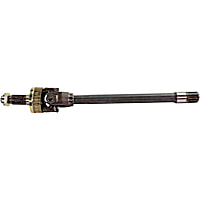There are quite a few things that can go wrong with the constant velocity (CV) axle assembly. Leaking grease and normal wear can cause its parts to deteriorate. How will you know if your vehicle’s CV assembly is failing? Below is a list of bad CV axle symptoms and other important information on the assembly.
What Does a CV Axle Do?
The CV axle (also called CV axle shaft and axle shaft) is responsible for transmitting torque from the transaxle or differential to the wheels. It also rotates the wheels at a constant speed, even as suspension changes can alter the CV shaft’s angle.

CV joints are better than standard u-joints because they can transmit power even if the axle is bent at a sharp angle.
How does the CV axle do this? The CV axle is similar to a bearing. It has an outer race and an inner race that has a ball bearing sandwiched in the middle.
Unlike a regular bearing where the inner race can spin independently from the outer race, a CV axle’s inner race and outer race are locked to spin together. The ball bearings allow the CV axle to lengthen, shorten, or bend.
This entire bearing is covered by a CV boot. The boot is filled with grease that lubricates and protects the joints from moisture and debris.
If water or other road debris gets inside the CV joint, it won’t be long before you start noticing signs such as abnormal sounds and vibration, as mentioned earlier.
Together, the CV axle, the joints, and the boots work as a system that ensures an efficient and comfortable ride.
What Causes a CV Axle to Fail?
CV axles and joints may wear faster than normal if the CV boot is ruptured. When this happens, the joints lose grease and are no longer properly lubricated. In very rare cases (like on some Toyotas) there may not have been enough lubricant in the joint from the manufacturer, which can lead to popping noise even if the CV joint boots are intact. So even if the boot isn’t torn and the joint is popping during turns, a new axle may be in order.
Moisture, water, and other road debris can also get inside the ruptured boot, making the CV joints vulnerable to faster wearing.
The joints will also fail prematurely if they’re put at an extreme angle because the vehicle’s suspension is modified. For example, a lifted truck may go through CV axles quickly.
In other instances, the CV joints may simply wear out over time.
How to Tell if Your CV Axle is Bad
A worn CV axle will show symptoms. Here are some of the signs of a bad CV axle shaft:
Clicking sound when turning
The most common sign of a faulty of worn CV axle is a clicking sound. When the CV axle gets worn down due to constant use, it can loosen the joints. As the outer joints become unstable, they may produce a distinct sound that some people describe as a click or a pop. This sound is most noticeable when you make sharp or fast turns while driving around corners.
This noise will be a click-click click sound that may only occur on turns originating from the worn CV axle. The reason it clicks and pops is that the channels in which the balls operate will have dimples where the balls spend most of their time. And during turning maneuvers, the balls will pass over those dimples again and again, making a machine-gunning pop each time the ball(s) cycle through the dimples they’ve worn into the channel.
This noise will be a clickclickclick sound that may only occur on turns originating from the worn CV axle. The reason it clicks and pops is that the channels in which the balls operate will have dimples where the balls spend most of their time, and during turning maneuvers, the balls will pass over those dimples again and again, making a machine-gunning pop each time the ball(s) cycle through the dimples they’ve worn into the channel.
–Richard McCuistian, ASE Certified Master Automobile Technician
You’ll hear the unusual clicking sound from the side of the vehicle with the faulty CV shaft. You might also feel vibration even while driving straight, as in this case:
Clunking sound when decelerating or accelerating
You may also hear unusual clunking or knocking sounds from the inner CV joint assembly when you decelerate or accelerate. In some cases, the inner joint will fail in such a way as to cause the powertrain to move back and forth laterally (sideways) when the vehicle is accelerating.
The sound may also come from an entirely different source, but hearing it should be a cause for concern.
Grease on the underside of the vehicle
You might ask, “What does a bad CV axle look like?” One of the tell tale signs is grease that has escaped from the boot. The CV boot is what keeps the CV joints lubricated so they can function properly. It’s made of high-quality rubber that doesn’t rupture easily.
However, if the boot gets damaged, the grease inside it will fling onto the underside of the vehicle as the axle turns.
Vibration while driving
One of the questions you might have is “Will a bad CV axle cause vibration?” A damaged axle shaft or CV joint can affect the balance of the whole assembly as it rotates. When this happens, the shaft may vibrate excessively. These vibrations can intensify as you accelerate.
If your CV axle is showing these symptoms, you’re probably wondering what happens if the CV axle breaks? If a CV joint fails while driving, your vehicle will begin to pull to one side as one wheel loses power. When the joint entirely fails, the corresponding wheel will no longer turn and the wheel won’t spin, even though the engine is continuing to rev.
Check out this video for tips on how to replace your rear axle shaft:

How Long Can You Drive on a Bad CV Axle?
You might be wondering what happens when a CV axle breaks. If one of the CV axle joints fails completely, you could lose control of your vehicle. Although this isn’t very likely to happen.
Some Notes About CV Axles
If the drive axles are on the front, the outer CV axle allows for evenly delivered torque to be transmitted even though the angle of the joint is up to 45 degrees during a pull and a turn. Standard u-joints speed up and slow down (and you can feel it) if a u-joint equipped shaft is bent at too sharp an angle during torque events. Thus, the joint we’re discussing here is called a “constant velocity” joint because it evenly transmits torque through all angles of operation.
The inner CV joint doesn’t need to endure such steep angles and will typically have a different design. Rather than balls in channels, the inner CV joint will have rollers (usually 3 of them in special wide channels spaced at 120 degrees) and the inner CV joint will be a plunging style joint to allow the CV axle to lengthen and shorten as the suspension works.
The joints are protected by a rubber boot filled with grease. In rare circumstances, a CV joint will be assembled at the factory with an insufficient amount of grease, which may cause the joint to wear out prematurely. Most outer joints have six balls and channels, but some (like Toyota Camrys) will have 8 balls and channels on their outer joints.
If the CV joint boot is compromised (torn) and the grease is lost, the joint will wear out much more quickly – even if most of the grease remains in the joint, sand and dirt will be absorbed into the grease so that it becomes a grinding compound and wears out the CV joint very rapidly.
Together, the shaft, the joints, and the boot make up the CV axle assembly. In the old days, we’d replace CV joint boots and the joints themselves, but more recently it makes more sense to simply replace the entire axle assembly.
Some late-model vehicles come equipped with independent rear suspension and many four-wheel and all-wheel vehicles also have CV axles but on rear CV axles there is not a significant joint angle change such as there is with the outer CV joints on front drive vehicles. The CV axle improves the quality of the ride and the cornering ability of the vehicle with these suspension systems, especially on off-road terrain. Most four wheel drive vehicles have CV axles that deliver torque to the front wheels in four wheel drive mode.
Check out these videos for tips on how to replace your CV axle:
Can You Replace Your CV Axle at Home?
Yes you can. However, you’ll need to have a flat space and some tools to lift your vehicle, such as a jack, jack stands, and power tools. If you have the right equipment, you can save a lot if you replace your faulty CV axle yourself, rather than leave the task to a mechanic.
Tips for Replacing a CV Axle
- Find the flattest place to do the job since the vehicle will need to be lifted on jack stands. This won’t be possible on an incline.
- There’s a lot of online resources where you can learn the process of replacing a CV axle. Try to find resources that are specific to your vehicle and consult your vehicle’s owner’s manual.
- If you’re uncomfortable with the process, don’t be afraid to leave the task to a professional mechanic. The last thing you want is to get stuck in the middle of the process where you won’t be able to drive the vehicle to the shop.
- Try to look for other faulty suspension and brake components during the repair process. This way, you’ll be able to fix those other components before you get the vehicle off the jack stands.
How Much Will a Replacement CV Axle Cost?
Most CV axles start at around $50 to $100 for one piece. As a set, they can cost up to $100 to $200. These sets come with the CV axles for both the left and right drive wheels.
CV axles can come bundled with other suspension and drivetrain components such as the sway bar links, pitman arm, wheel hubs, and tie rod ends. These bundles can be useful if you’re repairing a vehicle that was damaged in a crash.
Finding a CV Axle Replacement for Your Ride
A bad CV axle can make your ride both uncomfortable and unsafe. Don’t delay replacing the failed part, shop now at CarParts.com.
You don’t have to leave the comforts of your home just to get top-notch CV axle parts for your vehicle. With just a few clicks, you can find the right part for your vehicle. Simply go to our website, use our built-in vehicle selector, and place your order with just a few clicks.
Need to get back on the road soon? We’ll get the parts you need delivered to your doorstep in as fast as two business days.
Your shopping experience is important to us. If you have questions about your order, you can contact us through our toll-free hotline. One of our team members will be happy to assist you.
Check out our selection now, and get the best deal on a new CV axle assembly for your ride!
Products Mentioned in this Guide
Shop this Project



Any information provided on this Website is for informational purposes only and is not intended to replace consultation with a professional mechanic. The accuracy and timeliness of the information may change from the time of publication.


 Axle Shaft
Axle Shaft
 Axle Assembly
Axle Assembly
 CV Joint
CV Joint

































